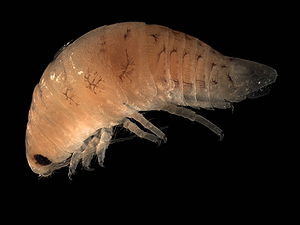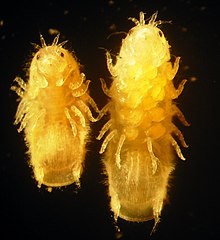Flabellifera
| Flabellifera | ||||||||||
|---|---|---|---|---|---|---|---|---|---|---|

|
||||||||||
| Systematics | ||||||||||
|
||||||||||
| Scientific name | ||||||||||
| Flabellifera | ||||||||||
| Sars , 1882 |


As Flabellifera an obsolete is taxon within the scheme of Asseln designated (Isopoda). As the second largest suborder of the woodlice, this comprised more than 3000 different species . However, it turned out that the group should not be viewed as monophyletic . Therefore, from 2003 onwards, their families were divided into the newly established suborders Cymothoida , Limnoriidea , Sphaeromatidea and the two smaller suborders Phoratopidea and Tainisopidea . At the same time the cymothoida were associated with other earlier suborders. However, the new system has not yet been established everywhere and the Flabellifera therefore still play a role in many publications and presentations of the system until the relationships of some subgroups have been clarified.
features
The body is elongated, its length varies from a few millimeters in the wood-boring Limnoriidae to 45 centimeters in the giant isopods of the deep sea . At the end of the abdomen , one to five free segments form the pleon , to which the pleo telson comes at the end . This is in striking Flabellifera long and wide and, together with the side springing uropods a fan-shaped attachment that Flabellum is called and the group gave its name.
The eyes are usually large and well developed, but in cave-dwelling and deep-sea species they are receded or absent. The mouthparts are usually sturdy and suitable for cutting, rasping and occasionally piercing. The first and second maxillae are two-branched. A rostrum is not developed.
The striding legs are usually designed in the same way, in the Serolidae , some Cirolanidae and the Sphaeromatidae species, the front pairs can be equipped with scissors or gripping tools. The five pairs of broad and flat hind legs ( pleopods ) are well developed, with the second pleopods forming the gonopodium in males .
Occurrence and way of life
The Flabellifera are found worldwide in sea water , brackish water and fresh water . Some families are predatory or scavengers, such as B. the Cirolanidae, Corallanidae and Serolidae, others are temporarily parasitic like the species of the Aegidae family, still others live permanently as parasites on and in fish, the representatives of the Cymothoidae family, including the species Cymothoa exigua , are known for this .
Species of the Limnoriidae family drill in algae and wood, including the wood drill Limnoria lignorum , which lives in and from the wood of ships and port facilities. The digestion of cellulose and lignin takes place through the formation of its own enzymes and not with the help of symbiotic bacteria, as is the case with many other organisms . The Sphaeromatidae are also herbivores or feed on diatoms and detritus .
Systematics
Familys
Until the revision of the Flabellifera in 2003, the group comprised 18 families:
- Aegidae White, 1850
- Ancinidae Dana, 1852
- Anuropidae Stebbing, 1893
- Bathynataliidae Kensley, 1978
- Cirolanidae Dana, 1852
- Corallanidae Hansen, 1890
- Cymothoidae Leach, 1814
- Hadromastacidae Bruce & Muller, 1991
- Keuphyliidae Bruce, 1980
- Limnoriidae White, 1850
- Phoratopodidae Hale, 1925
- Protognathiidae Wägele & Brandt, 1988
- Plakarthriidae Hansen, 1905
- Serolidae Dana, 1852
- Sphaeromatidae Latreille, 1825
- Tainisopidae Wilson, 2003
- Tecticipitidae Bruce, 1993
- Tridentellidae Bruce, 1984
division
In 2003 the families of the Flabellifera were divided into the following five new suborders of the woodlice:
- Suborder Sphaeromatidea
- Superfamily Sphaeromatoidea
- Family Ancinidae
- Family Sphaeromatidae
- Family Tecticipitidae
- Superfamily Seroloidea
- Family Basserolidae
- Family Bathynataliidae
- Family Plakarthriidae
- Family Serolidae
- Superfamily Sphaeromatoidea
- Subordination Limnoriidea
- Superfamily Limnorioidea
- Family Hadromastacidae
- Family Keuphyliidae
- Limnoriidae family
- Superfamily Limnorioidea
- Subordination Phoratopidea
- Phoratopodidae family
- Subordination Tainisopidea
- Family Tainisopidae
- Suborder Cymothoida
- Superfamily Cymothooidea
- Family Aegidae
- Family Anuropidae
- Family Barybrotidae (contains only Barybrotes indus )
- Family Cirolanidae
- Family Corallanidae
- Family Cymothoidae
- Family Gnathiidae
- Family Protognathiidae
- Family Tridentellidae
- Superfamily Cymothooidea
The Gnathiidae family comes from the earlier suborder Gnathiidea. To the superfamily Cymothooidea within the Cymothoida there are the superfamilies Bopyroidea and Cryptoniscoidea with the families of the earlier Epicaridea . Another superfamily of the Cymothoida are the Anthuroidea , which consist of the families of the earlier suborder Anthuridea .
Individual evidence
- ↑ a b c J. K. Lowry: Flabellifera . In: Crustacea: The Higher Taxa . Crustacea.net. November 2, 1999. Retrieved December 29, 2010.
- ^ A b Richard Brusca, Vania R. Coelho & Stefano Taiti: Suborder Flabellifera . In: Guide to the Coastal Marine Isopods of California . Tree of Life Web Project . Retrieved January 28, 2009.
- ↑ a b Angelika Brandt and Gary CB Poore: Higher classification of the flabelliferan and related Isopoda based on a reappraisal of relationships. Invertebrate Systematics, 17, 6, pp. 893-923, 2003 doi : 10.1071 / IS02032
- ↑ Taxon Details for Isopoda at WoRMS (accessed on August 25, 2010)
- ↑ Flabellifera Sars, 1882 at ITIS (accessed on August 25, 2010)
- ↑ Christopher G. Morris: Academic Press dictionary of science and technology. Academic Press, 1992, p. 839 ISBN 0-12200-400-0
- ^ EH Williams, L. Bunkley-Williams: New records of fish-parasitic isopods (Cymothoidae) in the eastern pacific (Galapagos and Costa Rica) . Noticias de Galapagos. 62 pp. 21–23, 2003 Online (PDF, English)
- ↑ Horror of the seafarers: the wood drill Limnoria lignorum ( Memento of the original of May 12, 2013 in the Internet Archive ) Info: The archive link was inserted automatically and has not yet been checked. Please check the original and archive link according to the instructions and then remove this notice. PDF of the Alfred Wegener Institute for Polar and Marine Research
- ↑ Limnoria lignorum in organisms lexicon of vegetation Atlas
- ↑ Joel W. Martin and George E. Davis: An Updated Classification of the Recent Crustacea. Natural History Museum of Los Angeles, Science Series 39, 2001, p. 124 ISBN 1-891276-27-1